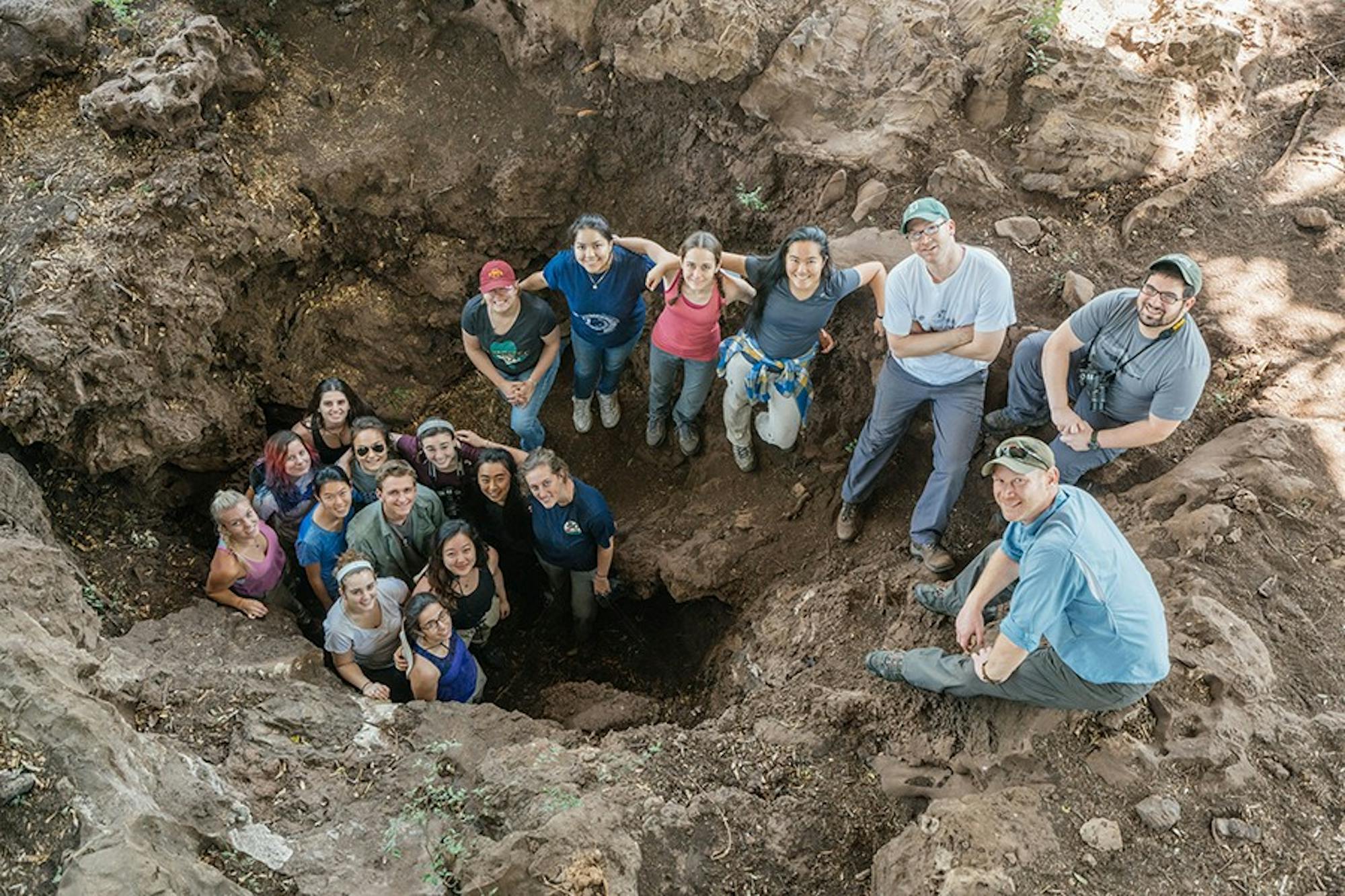As a child, Keira Byno ’19 always had an eye for finding shark teeth on the beach. However, she had not expected to find a two million-year-old fossil while excavating in the Malapa Fossil Site within the Cradle of Humankind, a UNESCO World Heritage Site northwest of Johannesburg, South Africa.
Byno, along with Julia Cohen ’18 and Kathleen Li ’17, made the discovery as part of the 15-person 2016 fall term class Anthropology 70, “Experiencing Human Origins and Evolution,” taught by anthropology professors Jeremy DeSilva and Nathaniel Dominy.
The class was designed as an experiential learning course, with the first 10 weeks spent discussing South Africa’s political history, indigenous groups such as the San and role in human evolution and biological anthropology.
The students then spent three weeks over winter interim in South Africa where they traveled to their Malapa campsite and excavated the site for three days, participated in safari trips to see native species of lions and leopards and listened to lectures from various explorers and professors.
The class was excavating a site that was created in 2008 by Lee Berger, a renowned paleoanthropologist who traveled with the students on the trip. According to DeSilva, Berger’s 9-year-old son discovered the first fossils of the original species known to live in the area, Australopithecus sediba.
Byno made the fossil discovery on the second day of excavations when Cohen and Li dug up and dusted two rocks that they gave to her to sift. She did not know that the rocks contained two separate pieces of the fossil but soon realized after sifting through the first rock. Byno told an experienced staff member about her discovery, who immediately took it to Berger and DeSilva. DeSilva said that Berger originally thought that the bone was part of the scapula, but he thought the bone was part of the pelvis.
Moments later, Byno sifted through the second rock and found another fossil. The two fossils fit together to form a bone, which Berger and DeSilva concluded that the bone was from the pelvis of a female.
The bone was not a large discovery considering the millions of fossils found to date, but it does help further understanding about the locomotion and process of childbirth in female species of A. sediba, DeSilva said. The discovery will be analyzed for about a year in a high-technology lab to confirm that the bone is part of a pelvis.
DeSilva said that he was not expecting his students to find anything on the trip, as he intended for them to experience the sometimes difficult process of finding fossils.
“Fossils are difficult to find, but I got a jolt of excitement when Keira found the bone,” DeSilva said. “I think the students learned a nice lesson about how science works — you make a claim, test it and revise it when new information becomes available.”
Cohen said that there is a one in 250,000 chance of finding a hominid fossil, and that she was very happy to have seen the class’s hard work pay off.
“Everyone was really excited about it,” Cohen said. “We all gathered around the fossil and passed it around while Professor DeSilva was contagious with enthusiasm.”
Li added that she did not expect anyone to find a fossil because the group had been working for eight hours a day to no avail.
“It was a lot of hard manual labor that was exciting at first, but got boring quickly. I couldn’t believe what was happening when we had found a fossil because it felt like history was sitting in our hands,” she said.
Abby Reynolds ’17, another student on the trip, noted that the discovery was a group effort and that everyone was involved in the fossil finding.
“The discovery was collective, because it could have been anyone who found the fossil,” said Reynolds about the excavation process.
While the discovery was helpful, DeSilva said that it is not unlikely to find a fossil in the Cradle of Humankind because the area has been a productive site for fossil finds.
In addition to the excavations, the students conducted individual projects that they planned during the fall and carried out in South Africa. The projects were about various subjects related to anthropology in South Africa, such as indigenous groups and political history.
Byno based her project on the indigenous San, asking them questions related to their ethnography and experience in South Africa.
Another project focused on the lack of education involving anthropology in South Africa, a hotbed for fossil discoveries.
Kalei Akau ’18 said that the trip confirmed her interest in anthropology and that she appreciated the real-life experience.
Reynolds added that her childhood dream of becoming a paleontologist came true when she got to dig at Malapa. Although she is a biomedical engineering major, she said that the trip reaffirmed her interests in paleontology and anthropology.
Byno had already been set on an anthropology major because of two previous classes with DeSilva, but finding the fossil made her think about going to field school to work more with paleoanthropology.
She added that one of the highlights of the trip was when the group’s car broke down from a flat tire and their lights went out during the safari trip. She explained that DeSilva and Berger had to exit the car carefully to avoid surrounding lions, one of whom was five feet away munching on an impala.
DeSilva said that he thought that experience was scary but powerful in that it became a teachable moment, in making the class think about what humans lived like two million years ago.
“Everyone was thinking about how early humans might have survived with ideas like they climbed trees to avoid the lions,” he said. “It made me excited to hear their conversations about how to not be eaten by lions and the experiences of early humans.”




